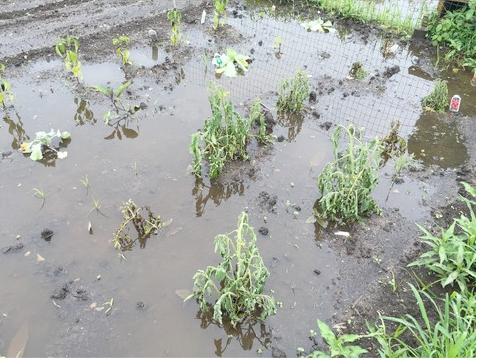By Urban Harvest

After Hurricane Harvey and the widespread flooding all around Houston and southeast Texas, we have received many calls about taking care of gardens and landscapes that have been flooded. Below are quick tips to guide anyone through the process of working to revive a garden.
1. Wash the plants. It seems counter-intuitive to add more water now, but mud and debris can reduce photosynthesis which is essential to plant growth and health. This will also rinse off most other light surface contaminates such as road oils or sewage contamination.
2. Don’t eat inundated veggies or fruits. Washing and boiling may remove bacteria, but it will not remove chemicals or roadway contaminants.
3. Clean up, but don’t rush to prune. Clean up broken limbs, fallen leaves, and rotting material. It can harbor diseases. Wait until you are sure there is die-back before you prune. Stress from water-logged soil may cause some leaves on fruit trees and herbs to yellow and drop off, but the branches are not necessarily dead. New leaf buds will begin to grow in a few days.
4. Don’t work the wet soil. Working wet soil can do long term damage to the soil structure itself. Allow the soil to dry out for several days. Push a trowel into the soil and rock it back and forth, if visible water is in the hole, you hear a “sucking” sound, or the soil at the walls of the hole looks glossy, wait a few more days and test again.
5. Don’t rush to replant. Soil biology is damaged when soils are water-logged for long periods of time. This affects the availability of nutrients for plant use. If you must replant quickly in the vegetable garden, support the soil biology with added compost, dried molasses, and perhaps added mychorrhizae fungi.
6. Replace nutrients. A light fertilization will replace nutrients that have leached from the soil during heavy rainfall. Foliar feeding with Ocean Harvest can quickly boost needed minerals to reduce plant stress.
7. Be prepared to deal with pests and disease. Water stress weakens plants. Weakened plants are susceptible to attacks. Fungal diseases are common after periods of heavy rain. Pull mulches back from the base of fruit tree, herbs, and vegetables until it dries out. Be prepared to take quick action with organic-approved fungicides and pesticides.
8. Dealing with contaminated storm water. If your garden has been inundated with city or residential storm water, chances are you will have to deal with contamination issues. Storm water is often contaminated with raw sewage, garden chemicals, and hydrocarbons. If you have visibly contaminated water, such as the sheen of oil on the surface, consult a professional.
You will need a soil test from a laboratory that can identify the contaminants and help you assess the situation and develop a remediation strategy. All is not lost in this case. Time and good soil biology will deal with sewage exposure. There are natural bio-inoculants that digest hydrocarbons. It will take time, but nature will overcome it.
9. Make an action plan. One of the best things you can do after a heavy rain is to assess your landscape. Get a clipboard and a camera. Make notes and take pictures of places where water stands for longer periods of time. Make a list of plants that seem more sensitive to wet soils. Use this information to help you make future decisions such as raising beds, improving soil texture, and plant selection.
This column is produced by Urban Harvest. Learn about our farmers markets, youth school programs, gardening classes, community gardens and orchards, and more at the Urban Harvest website or call 713.880.5540. The article was written by Angela Chandler, who is a life-long hobby gardener. She holds specialist certifications in Plant Propagation, Entomology, Rainwater Harvesting, and Greenhouse Management. She enjoys teaching a variety of garden subjects and she blogs regularly on her site thegardenacademy.com. She tends a one-acre garden in Highlands, Texas that includes vegetables, fruits, herbs, ornamentals, a small home nursery, chickens, goats and beehives.